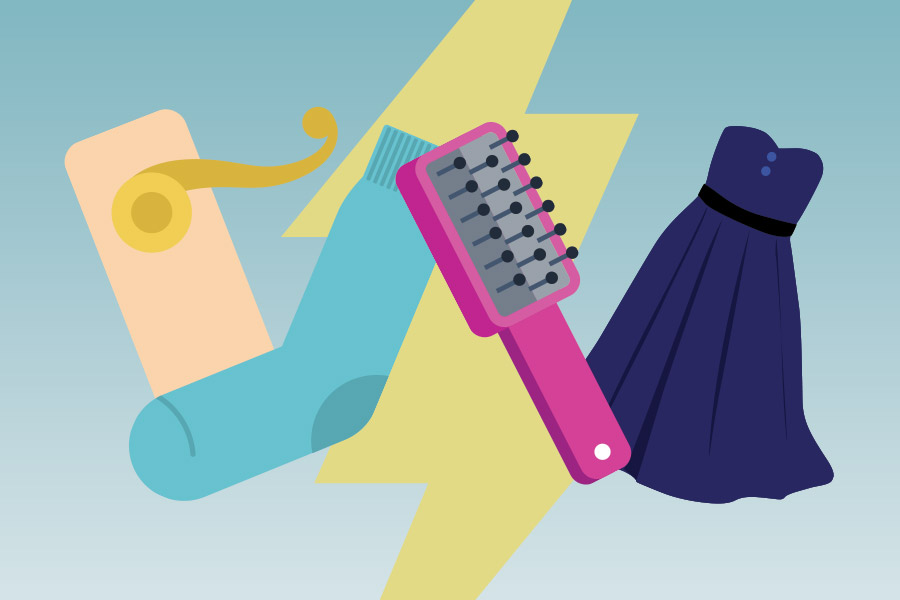
Your clothes cling to your limbs, your hair stands on end, and every doorknob greets your hand with a zap. Just what is static anyway, and why is it all up in your business this time of year?
Explanations of static can get complicated in a hurry—at least to non-physicists. But in simple terms, static is the buildup of a positive or negative electrical charge, says Troy Shinbrot, a professor of biomedical engineering at Rutgers and editor of the journal Physics Review Applied.
Everything on Earth—you, your hairbrush, your sweater—is made up of atoms. These atoms contain positively charged protons and negatively charged electrons, which typically balance one another out so that each atom has a “neutral” charge. But when two objects rub against each other—say, your sweater and the metal insides of your dryer—their atoms comingle. When that comingling happens, electrons can break free of their atoms and clump onto others, Shinbrot says.
In the world of atoms, opposites attract. A proton and an electron will pull toward each other, while two electrons will repel each other. If, after rubbing against the metal insides of your dryer, your sweater comes out with a surplus or deficit of electrons, those atomic imbalances will cause parts of the sweater to cling together—and to your skin, Shinbrot says.
These same sorts of imbalances, or “charges”, explain why your hair sometimes gets all fuzzy and flyaway, says Robert Hazen, a professor of Earth sciences at George Mason University. Rubbing a comb or brush against your hair leaves each follicle with a positive charge. All those positively charged hair follicles repel each other. “Like people on a crowded beach who want to put space between themselves, they all stand up and spread out,” Hazen explains.
What’s the deal with those doorknob shocks? When you shuffle across a carpeted floor in your stockinged feet, your body is collecting or shedding electrons and building up a charge, Hazen explains. This tends not to happen if you have wood floors—or wood-soled shoes—because wood does not readily grab onto or get rid of electrons.
Unlike wood, metal objects allow the easy flow of electrons and are happy to take on more. So when you grab ahold of a metal knob (or touch your metal computer), whatever charge you picked up shifts over to that metal object, Hazen says. If that shift is big enough, it can cause a spark and a small electric shock. The same kind of reaction is occurring at a much grander level when lightning strikes.
If you’re wondering why all these static electric hassles happen more in winter than in summer, Hazen says you can thank humidity for your cling-free clothes and shockless doorknob encounters. The water molecules in humid air attract any positive or negative charges that build up on your hair or body, making shocks or cling a lot less likely, he says.
That info is helpful even during the winter months. If you’re struggling with static cling, spritz a little water on your garment or—even better—rub moisturizer on your skin. That should dispel static in the same way seasonal humidity keeps your clothes flowing and flopping freely. Likewise, washing your hair less in winter—and so allowing it to accumulate oil—can keep your locks from floating away.
Dryer sheets are also an effective option, Shinbrot says. They’re loaded with positively charged ingredients that knock down the negative charges static-y clothes accumulate. There are some questions about the safety of their ingredients, particularly their fragrance. So, rather than tossing in a sheet with every load of laundry, you could keep a box of unscented dryer sheets handy at home or work to rub on clothing that gets a little too clingy. You can keep reusing the same sheet over and over again for weeks.
Tossing a damp washcloth into your dryer for the last 5 minutes of its cycle should also help. As long as you don’t completely dry out the cloth, the moisture it contains should soak up the static from your duds.
Finally, the thin metal bristles of a carbon fiber brush—rubbed on your legs or clothing—can act as a “passive static eliminator,” Shinbrot says. Like touching a doorknob, the metal bristles will produce small discharges and generate charged ions in the air, relieving the clothes of their charge.
More Must-Reads from TIME
- Cybersecurity Experts Are Sounding the Alarm on DOGE
- Meet the 2025 Women of the Year
- The Harsh Truth About Disability Inclusion
- Why Do More Young Adults Have Cancer?
- Colman Domingo Leads With Radical Love
- How to Get Better at Doing Things Alone
- Michelle Zauner Stares Down the Darkness
Contact us at letters@time.com